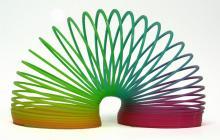
The Slinky toy has been enjoyed by generations of children since its introduction in 1946. It is a simple toy made of a coiled spring that is advertised with words to describe the many actions children can make it do: walk, bounce, spring, juggle, flip, and jiggle. The Slinky is described with the slogan, “The original walking spring toy walks downstairs,” and this feat fascinates children and adults alike when demonstrated.1
The idea for inventing the Slinky was the result of an accident. During World War II, Richard James was employed at the Cramp’s Shipyard near Philadelphia as an engineer working with flexible coil springs attempting to eliminate vibration on sensitive meters used on naval ships due to heavy seas, the recoil of gunfire, and the steel propeller shafts. When one of the hundreds of coils he had experimented with fell from his desk, the “amusing bouncing, tumbling gyrations” intrigued him. He took the coil home to his young son who in his play sent it down the stairs where “the coil threw itself into a loop, landed on the next step, lifted its tail, and threw itself into another loop, and so on down the long stairway.” The Slinky was born.2
Richard experimented for two years with coils of wire, and by 1945 he concluded that a flat ribbon of plain steel wire with zero tension and compression worked best to give him the end-over-end movement that he wanted. The finished product was a 2.5-inch stack of 98 coils.3 His wife Betty James named their toy by searching through the dictionary. She felt the word slinky best described “the sinuous and graceful movement and the soft sound of the expanding and contracting metal coil.”4
Their initial efforts at marketing the new toy were discouraging, but a large department store in Philadelphia, Gimbels, agreed to sell 400 of their toys. On November 27, 1945, Richard demonstrated their Slinky to a group of Gimbels’ customers who quickly bought out their entire inventory within 90 minutes. With borrowed money, they had more Slinkys manufactured and sold 22,000 by that Christmas. With success in sight, Richard designed their own equipment to manufacture the toys and started James Industries. The Slinky was introduced at the American Toy Fair in 1946 and its popularity grew in the 1950s.5
In 1958, Helen Herrick Malsed, a creator of toys and games, suggested that the Slinky could be used in the body of a pull-toy, and the Slinky Dog and Slinky Train toys were developed.6 Other Slinky toys were added to their line through the years, such as Slinky Jr., Plastic Slinky, Slinky Pets, Neon Slinky, and Crazy Eyes, which were glasses with Slinky-extended fake eyeballs.7
The Slinky toys maintained their popularity through the years, but on their 50th anniversary in 1995, a redesigned Slinky Dog featured in the Disney movie, “Toy Story,” produced a resurgence of interest in the toys.8
The Slinky has been used in a number of uses other than as a toy. Teachers have used them to demonstrate the properties of wave motion; NASA has used them in zero-gravity physics experiments in the Space Shuttle; and US soldiers in Vietnam used Slinkys as mobile radio antennas.9
James Industries was taken over by Betty James in 1960 after she and Richard divorced, and she moved the factory to her hometown of Hollidaysburg, Pennsylvania. The company remained a family-owned business until it was sold to Poof Products in 1998. Over 300 million Slinkys have been sold and they continue to be enjoyed by children around the world.10
The Slinky was inducted into the National Toy Hall of Fame in 2000 as a classic toy that has enjoyed popularity through the years.11 The Slinky has also been on display at the Smithsonian Institute in Washington, DC, and in the Metropolitan Museum of Art in New York City.12 The Discovery and History Channels included Slinky in their list of top ten toys of the 20th century, a 1999 commemorative stamp was issued by the U.S. Postal service honoring Slinky, and the Slinky was named the Official State Toy of Pennsylvania in 2001 by the General Assembly of Pennsylvania.13
- 1. “Slinky Spring Toys.” Poof-Slinky. < http://www.poof-slinky.com/Online-Store/Category/2/Slinky/ > 12 Jan. 2012.
- 2. “History of Slinky.” Slinky Print. < http://www.slinkyprint.com/slinky_history.htm > 12 Jan. 2012.
- 3. “Slinky Toy.” How Products Are Made. Volume 3. < http://www.madehow.com/Volume-3/Slinky-Toy.html > 11 Nov. 11.
- 4. Hevesi, Dennis. “Betty James, Who Named the Slinky Toy, Is Dead at 90.” The New York Times. Nov. 24, 2008. < http://www.nytimes.com/2008/11/25/business/25james.html > 12 Jan. 2012.
- 5. Op. cit., “History of Slinky.”
- 6. McDowell, Edwin. “Helen H. Malsed, 88, Creator of Slinky Toys.” The New York Times. November 29, 1998. < http://www.nytimes.com/1998/11/29/business/helen-h-malsed-88-creator-of-slinky-toys.html > 12 Jan. 2012.
- 7. Bellis, Mary. “History of the Slinky Toy.” About.com. < http://inventors.about.com/od/sstartinventions/a/slinky.htm > 11 Nov. 2011.
- 8. Witchel, Alex. “Talking Toys With: Betty James; Persevering for Family and Slinky.” The New York Times. < http://www.nytimes.com/1996/02/21/garden/talking-toys-with-betty-james-persevering-for-family-and-slinky.html > 12 Jan. 2012.
- 9. “Inventor of the Week. The Slinky.” Lemelson-MIT Program. Massachusetts Institute of Technology School of Engineering. < http://web.mit.edu/Invent/iow/slinky.html > 11 Nov. 2011.
- 10. Op. cit., “History of Slinky.”
- 11. “Slinky. Inducted 2000.” National Toy Hall of Fame. < http://www.toyhalloffame.org/toys/slinky > 12 Jan. 2012.
- 12. Op. cit., “Slinky Toy.”
- 13. “Slinky History – Invention of the Slinky.” The Great Idea Finder. < http://www.ideafinder.com/history/inventions/slinky.htm > 11 Nov. 2011.

